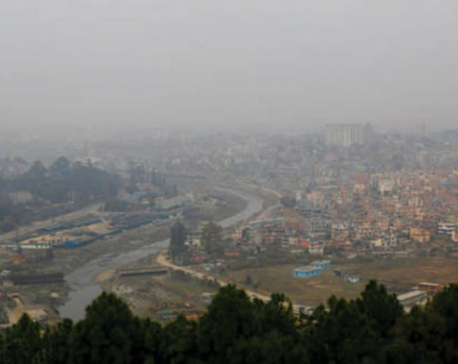
OR
Opinion

There is a simmering debate in Nepali politics that in spite of so much change in the political system (byawastha), there is little or no change in the living conditions (awastha) of the masses. This is what I call the Byawastha-Awastha hypothesis.
Over the last 70 years or so, we have moved from an autocratic monarchy to a state of federal democratic republic Nepal, trying as many as seven constitutions, yet the politics is deeply mired in a kind of never-ending transition. Political instability and uncertainty seems to have become a norm rather than an exception.
Chart 1 depicts the annual growth rate of GDP over the period of the last 60 years (1961-2021) superimposed by major political changes and incidents. It is drawn from the database maintained by the World Bank. Other than random, sharp ups and downs in the trend line, no distinct pattern can be observed in the chart. Had byawastha been a determining factor for our awastha, some distinct pattern could have emerged. With an average growth rate of 3.78 percent, minus, say 2 percent population growth rate, at a meager 2 percent growth rate, the economy must have been at a standstill position. Sixty years is a pretty long time for a country when there can be a miraculous transformation within a decade or so.
Now, we have several political parties seeking to address the byawastha-awastha hypothesis. At one end of the spectrum, we have the Rastriya Prajatantra Party (RPP) and its variants determined to change the byawastha so that the people’s awastha too can be changed. Fundamentally, they are determined to restore the dead monarchy. It is an irony to have a party determined to scrap the very constitution that it has taken its oath to protect and promote.
At the other end of the spectrum, there is a new political outfit called the Rastriya Swatantra Party (RSP) which, fundamentally, seeks to address the awastha without changing the byawastha. Officially, they have accepted the constitution; their primary agenda is to deliver services to the masses. Hence they are vocal with good governance and anti-corruption agenda.
The mainstream political parties like Nepali Congress, UML and the Maoist Centre are happy with the current byawastha (constitutional arrangement) as long as there is no diminution in their awastha. Remember Dr Baburam Bhattarai comparing the present constitution with a “half full-half empty paradox”, his party determined to work with or work in the half full part?
Earlier, using the Bertelsmann Transformation Index (BTI) for Nepal from 2003 to 2022, I concluded that Nepal’s transformation is more at the political front vis-à-vis the economic front. Using political transformation, as a proxy measure of changes in the byawastha and economic transformation as changes in the awastha, we can fairly say that we achieved some changes in the byawastha (political changes) without affecting our awasthav (economic condition). In fact, with economic and environmental pressures, our awastha could be on the decline. The BTI data also included two determining factors on governance performance - (a) overall difficulty situation and (b) capability of our policy makers. This is analogous to a game of football. The overall game performance is determined by (a) capability of the players and (b) the conditions of the ground. Definitely, the superb players can do little when it comes to playing on the rough and tough ground.
In the case of Nepal, the gains in governance performance has been achieved by the reduction in difficult situations rather than due to increase in overall capability of the policymakers. In fact, the Bertelsmann Foundation has termed the capability of our policy makers to be flawed.
So what are we trying to say here? Development is all about political settlement; it is about who holds the power; how it is being distributed and how benefits from power (rents) are shared by the elites and other members of society. There is a need for reviewing our political settlement.
Definitely, we have ejected the corrupt and tyrannical monarchy but our peace process and transitional justice is in jeopardy. We need to move beyond the jurisdiction of political parties and determine who holds de facto power, and benefit from the rents accrued to that power in Nepali society. In the new constitution, we have primarily outlined four principles, namely, federalism, secularism, republicanism and social inclusion. We need to analyze the vested interest groups working against or even seeking to prevent the implementation of these principles. A closer look at the workings and behaviors of the bureaucracy, the army and the judiciary will inform us that there has been little change in the byawastha resulting in no change or even a declining trend in the awastha.
You May Like This

An ode to Kathmandu
Dear Kathmandu, people’s perceptions toward you have been gradually changing with the changes in the political system of Nepal. The... Read More...

Brazilians demonstrate, strike to protest pension changes
SAO PAULO (AP) — A transport strike snarled traffic in Brazil's biggest city and demonstrators broke into the Finance Ministry... Read More...




Just In
- Govt receives 1,658 proposals for startup loans; Minimum of 50 points required for eligibility
- Unified Socialist leader Sodari appointed Sudurpaschim CM
- One Nepali dies in UAE flood
- Madhesh Province CM Yadav expands cabinet
- 12-hour OPD service at Damauli Hospital from Thursday
- Lawmaker Dr Sharma provides Rs 2 million to children's hospital
- BFIs' lending to private sector increases by only 4.3 percent to Rs 5.087 trillion in first eight months of current FY
- NEPSE nosedives 19.56 points; daily turnover falls to Rs 2.09 billion
















Leave A Comment